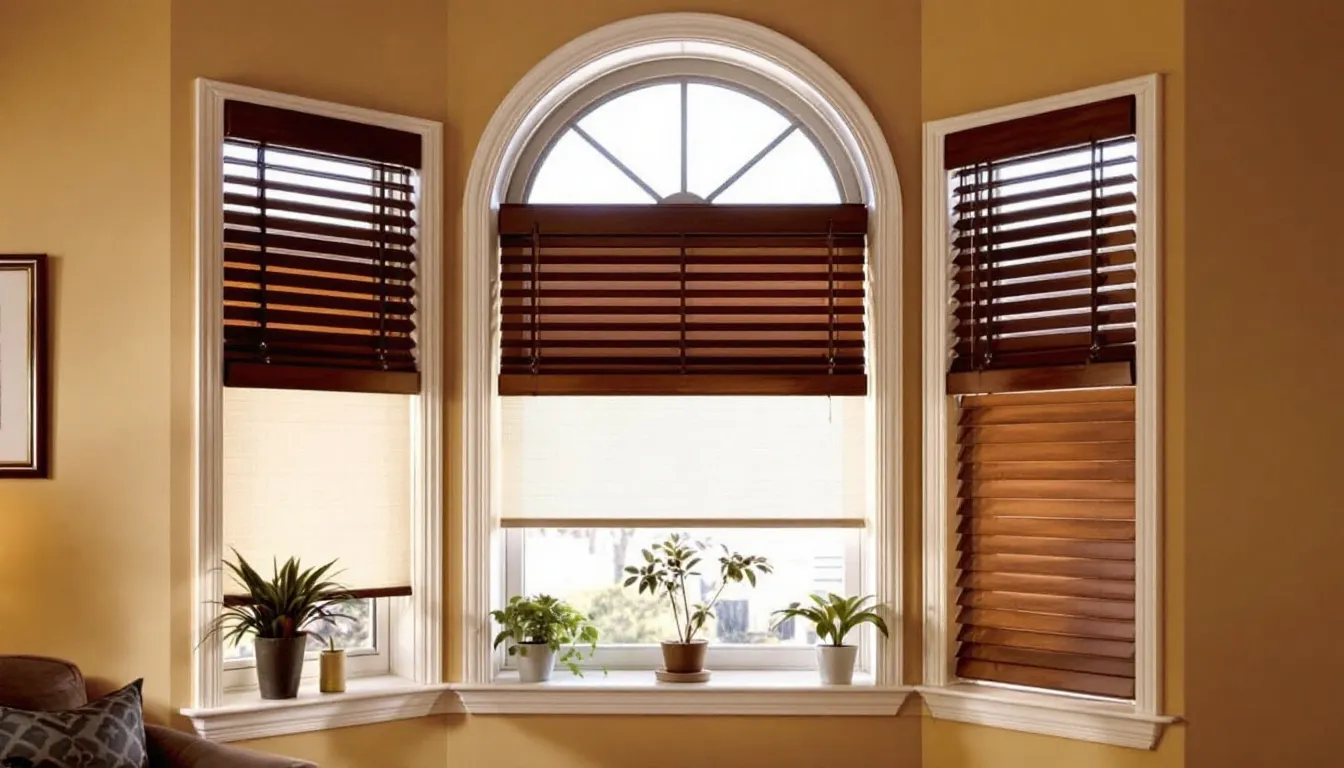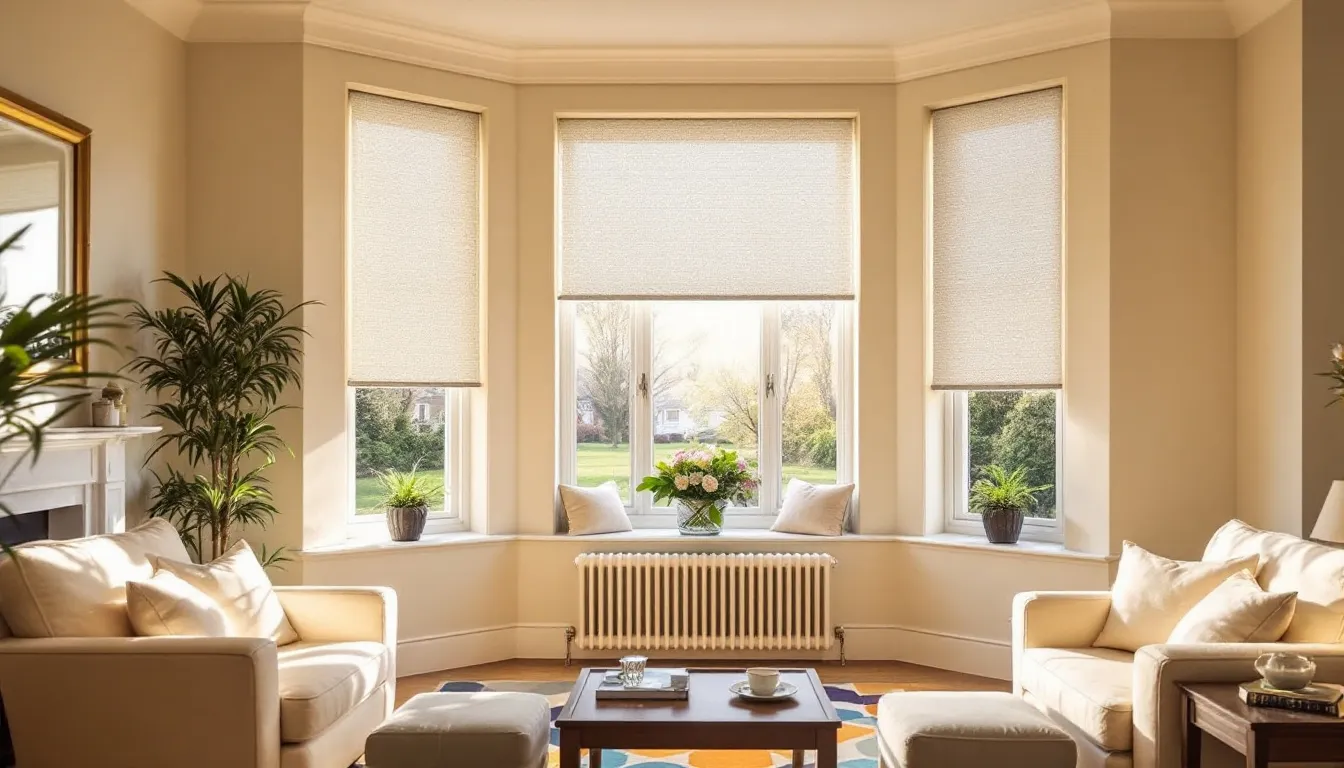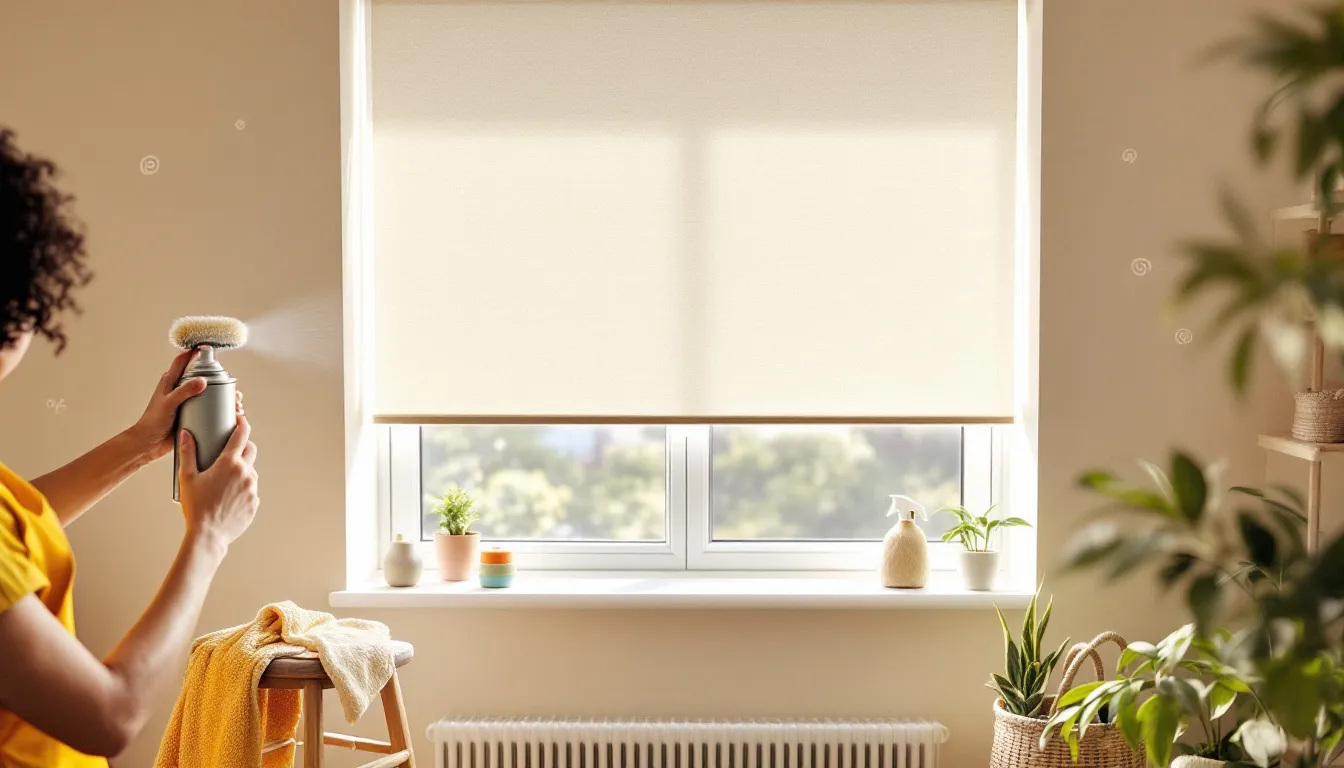
Want to know how to fit roller blinds in a bay window? This guide covers all the essential steps: measuring accurately, choosing the right blinds, and installing them perfectly. Follow this step-by-step process to achieve the best results for your bay windows.
Key Takeaways
Bay windows come in various styles, such as angled, box, oriel, and bow, each requiring tailored approaches for roller blind measurement and installation.
Accurate measurements and proper tools are essential for successfully fitting roller blinds in bay windows, considering potential obstructions like handles and angles.
Regular maintenance and cleaning of roller blinds enhance functionality and appearance, ensuring they operate smoothly and last longer.
Understanding Bay Windows

Bay windows are more than just a window; they are a statement of elegance and functionality. These architectural gems extend outward from the main walls and consist of three or more window panels, allowing natural light to flood in while offering panoramic views. Grasping the details of bay windows is key to fitting the ideal roller blinds. The unique construction of bay windows means that each type requires a tailored approach for the best results.
Bay windows are diverse, and recognising the different types and their specific features is crucial. Whether you have an angled bay window, a box bay window, or an oriel bay window, each design influences how you should measure, choose, and install your roller blinds. This understanding ensures both functionality and aesthetic harmony when you fit your bay window blinds.
Types of Bay Windows
Bay windows come in several styles, each with its unique charm. Angled bay windows, for instance, project outward with two angled side panels, creating a dynamic and spacious look. Box bay windows, on the other hand, feature a flat central panel with two side panels that are also angled, giving a box-like appearance that complements both modern and traditional aesthetics.
Oriel bay windows are another enchanting style, embedded into the wall of a building and often supported by decorative brackets. These windows add a touch of historical elegance to any home.
Bow bay windows, characterised by their soft, rounded appearance, consist of multiple window panels that create a graceful curve. Each type of bay window requires specific considerations when choosing and installing roller blinds to ensure a perfect fit, bay window blinds, and seamless operation with curved bay windows.
Measuring for Roller Blinds in Bay Windows

Precise measurements are fundamental for a successful roller blind installation. Consider potential obstructions like window handles or knobs when measuring for bay window blinds, as they can affect the fit. Double-checking the coloured measuring chart for the specific headrail projection of your chosen blind is also a key step to ensure a flawless installation.
To achieve a perfect fit, summarising potential obstructions and following a meticulous measurement process is crucial. This includes measuring each window pane individually and considering the angles and number of panels involved, as these factors can complicate the process.
Accurate measurements not only ensure functionality but also enhance the overall appearance of your bay windows.
Tools You Will Need
Equipping yourself with the right tools ensures accurate measurements and a seamless installation process. For measuring roller blinds in bay windows, you’ll need a metal tape measure, a pencil for marking, and brackets for installation. A fitting kit, which typically includes screws and other necessary hardware, is also crucial to facilitate the installation process.
These tools guarantee precise measurements and a secure fit for your roller blinds.
Step-by-Step Measurement Guide
Start by measuring each window pane individually, paying attention to the dimensions of the visible glass. This approach ensures that each roller blind fits snugly within its designated space. When dealing with angled bay windows, use paper strips to mark the corners, then measure from these marks to account for the angles. This technique helps in determining the exact meeting point of the blinds, a critical factor for angled bay window installations.
Next, measure the depth of the window frame in three places and use the smallest measurement to ensure a proper fit. This step is particularly important for ensuring that the blinds will operate smoothly without obstructions. Consulting the headrail chart can provide additional guidance on the correct depth measurement for your chosen blind.
Finally, when making cardboard cut-outs to check for clearance, include an extra 1 cm for window handles or other obstructions. Accurate measurements are crucial for avoiding fitting issues and ensuring that the roller blinds function seamlessly once installed.
Choosing the Right Roller Blinds for Your Bay Window

Selecting the right roller blinds for your bay windows goes beyond just choosing a preferred style. Custom-made blinds are often necessary for bay windows to match their unique dimensions and angles precisely. Custom-shaped roller blinds can be an effective solution for non-standard bay window dimensions, ensuring an exact fit and seamless operation.
Consider features like blackout options for optimal light control and privacy when choosing roller blinds. Additionally, think about how the blinds for bay windows will enhance the overall aesthetic of your bay windows while ensuring functionality. Ordering blinds in a recess size can also help avoid gaps between adjacent blinds, providing a cleaner look and better light control.
Material Options
There are various materials available for roller blinds, each offering different benefits. Faux wood blinds are popular for their resemblance to real wood and their greater moisture resistance, making them ideal for areas with high humidity. Light-filtering fabrics can soften natural light while providing a degree of privacy, making your room feel bright and airy without compromising privacy.
For those who prefer a traditional look, wooden blinds offer a timeless aesthetic but may require more maintenance. Blackout fabrics are excellent for rooms where light control and privacy are paramount. Knowing the advantages and disadvantages of each material aids in selecting the right roller blinds for your bay windows and window coverings, meeting both functional and aesthetic needs.
Customisation and Colours
Roller blinds can be tailored with various patterns and colours, allowing you to personalise them to match your room decor. Whether you prefer bold patterns or subtle hues, customised roller blinds can enhance the aesthetic appeal of your bay windows. Choosing coordinating colours for the blinds and hardware can create a cohesive look that ties the room together.
Consider the overall design theme of your room when selecting patterns and colours for your roller blinds. Whether you’re aiming for a minimalist look or a vibrant, eclectic style, the right customisations can make a significant difference. Free samples can help make these decisions, allow you to see how different options will look in your space.
Installing Roller Blinds in Bay Windows

Due to the unique angles and shapes, installing roller blinds in bay windows can be more intricate than standard window installations. However, with accurate measurements and the right tools, the process can be manageable and rewarding. Begin by marking the bracket positions on the window frame or ceiling, ensuring they are aligned correctly for a smooth operation.
It’s crucial to position and secure the brackets accurately to ensure the blinds fit well and function properly. Correct measurements are essential for the installation of bay window roller blinds, as the multiple blinds need to align perfectly to avoid gaps and ensure smooth operation.
Preparing for Installation
Ensure you have a fitting kit ready, containing all necessary hardware for installation, before you start to install your roller blinds. Measure the largest window handles or any other obstructions and add 1 cm for clearance to ensure the blinds can operate without interference.
Refer to the headrail chart to note the depth of your chosen blind and use a sharp pencil to mark measurements accurately. Using a projection guide can also help determine where to fit the blinds based on the depth of the window frame.
Ensure that the window area is clean and free of obstructions before starting the installation process. Adequate preparation ensures a smoother and more efficient installation process.
Fitting the Brackets
Verify the coloured measuring chart for the correct bracket positioning to ensure accuracy. After finding the correct position, mark the screw holes with a pencil and use heavy-duty Gripit fixings for securing brackets to plasterboard.
Place cut-outs at one angle with tips touching to mark positions for fitting, and repeat the steps for the blinds on either side of the bay to ensure alignment. Use a screwdriver to twist in the center of the grip fixing once flush with the ceiling, and ensure two holes are drilled for each bracket to secure it properly.
Add 1 cm for clearance when fitting the blinds and make necessary adjustments using a batten if the blinds cannot clear obstructions. Using all marks made on the window for precise positioning ensures accurate fitting of the blinds.
Mounting the Roller Blinds
Once the brackets are securely in place, position the roller blinds on the mounted brackets to ensure they align correctly for smooth operation. Aligning the roller mechanism properly is crucial for optimal function, preventing uneven rolling. This step ensures that the blinds operate smoothly and look aesthetically pleasing when installed.
Take your time to double-check all alignments and adjustments before finalising the installation. Ensuring that the blinds are mounted correctly will help in achieving excellent light control and a seamless appearance for your bay window blinds.
Common Challenges and Solutions
Installing roller blinds in bay windows comes with its own set of challenges. Common problems include irregular shapes, angles, and fitting issues. It’s essential to consider any obstructions, such as window handles or vents, that may interfere with the blinds. Ensuring that the blinds clear all obstructions or mounting them to a batten if necessary can provide adequate space for smooth operation.
Routine maintenance significantly enhances the durability and functionality of roller blinds. By addressing these common challenges head-on, you can ensure that your bay window blinds not only look great but also function seamlessly over time.
Dealing with Irregular Shapes
Angled bay windows, box bay windows, and oriel bay windows each have unique shapes that can impact the fitting of roller blinds. Recognising the distinctive characteristics of these bay window styles is critical for selecting and installing the right roller blinds. Accurate measurements of the visible glass size and angles in each panel are critical for ensuring a snug fit.
A step-by-step approach in measuring each window panel will ensure that the roller blinds fit perfectly and function smoothly. Selecting roller blinds that are adaptable to unique shapes can enhance both the aesthetics and functionality of your bay windows. Proper alignment and secure attachment are necessary for optimal performance when dealing with irregular bay shapes.
Ensuring Smooth Operation
To ensure the smooth operation of your roller blinds, adjustments to both the blinds and their brackets are important to prevent obstructions. Improper installation can lead to blinds obstructing one another, affecting their functionality. Lubricating the mechanisms of roller blinds periodically can improve their operation and prolong their lifespan.
Regularly checking the roller blinds for any signs of wear and tear can help prevent further damage and ensure smooth operation. Proper maintenance of your roller blinds ensures excellent light control and seamless functionality in your bay windows.
Maintenance Tips for Roller Blinds

Ongoing maintenance is key to prolonging the lifespan and ensuring the functionality of your roller blinds. Regularly cleaning your roller blinds with a soft cloth, vacuum, or mild soap solution keeps them looking fresh and new. Regular maintenance prevents issues and enhances the performance of your roller blinds over time.
Incorporating a consistent cleaning routine and addressing minor issues promptly ensures your roller blinds remain in optimal condition. This not only enhances their appearance but also extends their durability and functionality.
Cleaning Your Roller Blinds
Cleaning your bay window roller blinds is straightforward and can be done using a soft cloth, vacuum, or mild soap solution. The most effective way to clean bay window blinds is to dust with a feather duster, wipe with a damp microfiber cloth, and then dry immediately. This method helps in removing dust and dirt effectively without damaging the blinds.
A consistent cleaning routine can prolong the lifespan and enhance the performance of your roller blinds. Regular cleaning keeps your blinds looking good and ensures they operate smoothly and efficiently.
Regular Maintenance
Regular maintenance is essential to ensure that your roller blinds last longer and function properly. Use regular cleaning methods and maintenance techniques to keep your roller blinds in optimal condition. Periodic deep cleaning and lubricating the mechanisms can significantly enhance the lifespan and light control of roller blinds.
Regular maintenance prevents minor issues from becoming major problems. This proactive approach ensures that your blinds remain functional and visually appealing, providing you with excellent light control and smooth operation for years to come.
Summary
Fitting roller blinds in bay windows may seem daunting at first, but with the right knowledge and tools, it can be a rewarding and transformative project. Understanding the unique characteristics of bay windows, taking precise measurements, and choosing the right materials are all crucial steps in achieving a perfect fit. The installation process, while intricate, can be managed effectively by following a step-by-step approach and addressing common challenges head-on.
In conclusion, well-fitted roller blinds not only enhance the aesthetic appeal of your bay windows but also offer practical benefits such as light control and privacy. By following this expert guide, you can transform your bay windows into stunning focal points that elevate the overall look and feel of your home. Embrace the process, and enjoy the beautiful results.
Frequently Asked Questions
What are the most common types of bay windows?
The most common types of bay windows are angled bay windows, box bay windows, oriel bay windows, and bow bay windows. Each serves to enhance both aesthetic appeal and natural light in a space.
Why is accurate measurement crucial for fitting roller blinds in bay windows?
Accurate measurement is crucial for fitting roller blinds in bay windows to guarantee a seamless fit, preventing gaps and ensuring smooth operation without obstruction. This precision is key to achieving the desired aesthetic and functionality.
What materials are available for roller blinds, and which should I choose?
When choosing roller blinds, consider materials like faux wood, sheer fabrics, and blackout fabrics, selecting based on your requirements for light control and aesthetic preferences. Each option offers unique benefits, so determine what aligns best with your needs.
How can I ensure my roller blinds operate smoothly?
To ensure your roller blinds operate smoothly, regularly check for obstructions and lubricate the mechanisms. Additionally, make necessary adjustments to both the blinds and their brackets to prevent any issues.
What are the best methods for cleaning roller blinds?
The best methods for cleaning roller blinds include regular dusting, vacuuming, and using a damp microfiber cloth for wiping. Employing a mild soap solution can also effectively remove tougher stains, ensuring your blinds remain in excellent condition.
